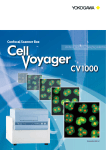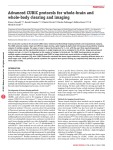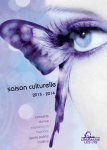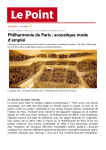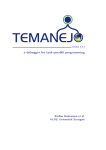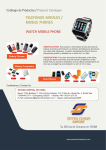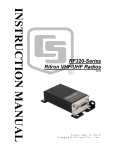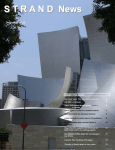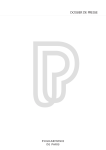Download Confocal scanner Box
Transcript
CV1000_表紙-p7.pdf 1 2012/06/05 9:21:59 Specification Model Main unit Type Confocal scanning method Scanning speed Excitation laser wavelength Bright field imaging Camera Type Effective no. of pixels 3-color model 405, 488, 561nm XY-stage Z-axis control Objective lens 【Standard】Dry: 10X 【Option】Up to 5 lenses can be added Dry: 10X, 20X, 40X Oil: 20X, 40X, 60X Water: 60X LWD: 20X, 40X Stage incubator*1 Utility box High-precision temperature controllable incubator 【Temperature】Range : 30 ‒ 40℃ (Room temperature +5℃ or higher) Designated resolution:0.1℃ 【Humidity control】Forced humidification with a water bath unit Work station Operating temperature Operating humidity level Power consumption M Y CM Confocal scanner Box All-in-one live cell imaging solution CellVoyager and CSU are registered trademarks of Yokogawa. Option Pinhole change unit Back-illuminated EMCCD Auto focus Attachment MY CY CMY *1 Option (Basic model) *2 CO2 gas cylinder not included with CV1000 system *3 When you use stage incubator, CO2 mixing unit is required *4 Option (3-color model,2-color model and single-color model) 50μm/25μm Switching time : 2sec Effective no. of pixels:1024×1024 Detection of glass surface with laser + offset For Single 35mm dish with Stage incubator *1*3 For Triple 35mm dishes with Stage incubator*3 For Glass chamber with Stage incubator*3 For Microplate For Slide glass *4 Layout ■Front view ■Plain view 1150 532 K − CO2 : 5% Gas cylinder : CO2*2 Slide glass attachment Single 35mm dish attachment with stage incubator W580×D835×H532 mm 93Kg W319×D368×H346 mm W319×D368×H518 mm 10Kg 16kg Sets conditions for imaging, camera, time lapse, environments*1, 3D imaging, map view acquisition,multi-color imaging , and multi-point imaging. Functions include image display. Output file type:16bit TIFF Controller work station, Display 15∼35℃(When operating temperature is over 30℃, water cooling of the camera is required.) 20∼70% RH (no condensation) 100∼240VAC/50 or 60Hz 1500VAmax CO2 Attachment External dimension Weight External dimension Weight Control software C CV1000 Basic model 2-color model Single-color model Microlens enhanced dual Nipkow disk scanning 1,500∼5,000rpm 488nm 488, 561nm 488nm − LED transmission Cooled CCD Back-illuminated EMCCD 1344×1024 512×512 High-precision auto X-Y stage Designated resolution: 0.1 μm Motorized Z-axis control Designated resolution: 0.1 μm 820 650 ・Recommended lab bench size 【Main unit】W820 X D1150 mm or larger Minimum clearance : front: 160 mm, back: 150 mm,above: 350 mm, side: 120 mm 【Utility box and Controller work station】W650 X D1130 mm or larger Minimum clearance : front: 50mm, back: 50 mm, side: 50 mm Safety Precautions * Read the user's manual carefully in order to use the instrumentcorrectly and safely. * This product falls under the category of class 1 laser products. YOKOGAWA ELECTRIC CORPORATION Life Science HQ Kanazawa 2-3 Hokuyodai, Kanazawa-shi, Ishikawa, 920-0177 Japan Phone: (81)-76-258-7028, Fax: (81)-76-258-7029 Tokyo 2-9-32 Nakacho, Musashino-shi, Tokyo, 180-8750 Japan Phone: (81)-422-52-5550, Fax: (81)-422-52-7300 Represented by: E-mail [email protected] URL: http://www.yokogawa.com/scanner All Rights Reserved.Copyright © 2010, Yokogawa Electric Corporation. [Ed:01/b] Printed in Japan, 1106 Bulletin80H01B01-01 E_CV1000_p1-p2_cs2.pdf 1 2012/06/05 9:22:30 All-in-one confocal imaging system: The ideal tool for long-term live cell imaging Confocal Scanner Box 《What makes the CV1000 ideal for long-term live cell imaging?》 Microlens enhanced dual Nipkow disk scanning A Nipkow spinning disk containing about 20,000 pinholes and a second spinning disk containing the same number of microlens to focus excitation laser light into each corresponding pinhole are mechanically fixed with a motor, and very rapidly raster scan the field of view with about 1,000 laser beams when rotated. Multi-beam scanning with the CSU not only increases scanning speed, but also results in significantly lower photo bleaching and photo toxicity, because multiple excitation needs only a low level of laser power at the specimen to fully excite fluorescence. More than 2,000 units of the CSU series are used as the de facto standard tool for live cell imaging, worldwide. Microlens array disk Light source Camera Rotation Lens Dichroic mirror Pinhole array disk Objecitive lens Sample Desktop imaging system 《All in one》 You no longer have to bother with complicated system setup. Get started right away with confocal live cell imaging! The CellVoyagerTM CV1000 Confocal Scanner Box is a fully integrated desktop imaging system. With its microlens enhanced dual Nipkow disk scanning technology, phototoxicity and photobleaching are drastically reduced, making it ideal for use in observing highly delicate life processes such as iPS/ES cell generation and embryogenesis. The system is easy to use and eliminates the need for a dark room. Easy to use Compact all-in-one unit Get started with just the push of a button. The custom-designed, easy-to-use software does all the hard work for you. No need for a dark room ‒ use the CV1000 right at your lab bench. Major advantages C Reliable environmental control Temperature is precisely controlled inside the stage incubator and measurement unit, keeping cells healthy for long periods. M Reduced photo damage Brighter images Reliable environmental control Y CM MY CY Precise reproducibility User friendly CMY K CSU (Dual Nipkow disk scanning) Ultra-high sensitivity EMCCD camera*1 Stage incubator with high-precision temperature/CO2 control*1 High-precision auto X-Y stage Easy-to-use integrated software Live cell imaging is no longer difficult or complicated ‒ get started right away! Excitation Fluorescence Stage incubator Double-disk unit with two pinhole sizes*2 Select the optimal pinhole size depending on the magnification. A direct optical path setting is available for bright field imaging. ■Want to do long-term time lapse imaging? The CV1000 is the compact all-in-one confocal system that you can install and get started using right away at your lab bench. It eliminates the need for setting up a microscope, using a dark room, and carefully controlling room temperature. ■Are you having trouble getting the optimal live cell imaging setup? The CV1000 uses a dual Nipkow disk confocal scanner, the de facto standard tool for live cell imaging that minimizes phototoxicity and photobleaching. The system s incubator keeps delicate embryos, ES/iPS cells,and other types of cells healthy and at a stable temperature for the entire duration of your experiment. 《Versatile range of attachments for various specimen types》 The area of tenperature control Attachments*2 From high-end multi-point, long-term time lapse imaging to single shots of fixed cells Select the attachment that best meets your requirements. Use an attachment together with the stage incubator (for 35mm dish, 35mm 3-dish, glass chamber) to keep cells healthy during time lapse imaging. Attachments for micro-plates with up to 96 wells are available. ■Do you need to observe different specimen types and lack the time to train users? The CV1000 comes with a variety of attachments suitable for applications ranging from high-end multi-point, multi-color time lapse imaging of live cells to single shot high-resolution imaging of fixed specimens. The software is easy to use ‒ even first time users can quickly master it. This combination of hardware and software makes the CV1000 the ideal tool for research facilities. 1 *1 Optional feature on the basic model 35mm dish *2 Option 35mm 3-dish Glass chamber Slide glass Micro-plate 2 E_CV1000_p3-p4_cs2.pdf 1 2012/06/05 9:23:41 User friendly Observation procedure 《Easy setting even for complicated multi-point time lapse imaging》 Insert the sample Adjust the z-stroke (focus position) Capture a map view image of the entire area (This can take up to one minute) to easily identify the target area Click on the map view area to set the recording area Select the time lapse settings ● REC While recording time lapse images, you can view and compare previously recorded images as well as the current images ‒ a very useful function for long-term time lapse experiments. Repeat steps 3 and 4 to set multi-points 《Friendly to both the user and cells!》 Push the REC button to begin recording! 《Easy selection of optimal condition》 Control software Automatic objective lens switching / Double-disk unit*1 Map view: Efficient sample search function X-Y map view images covering a wide image area are automatically generated for easy comprehension of sample distributions. The map view function lets you view specific image areas with the same ease of use as a Web based map search function. Local magnification selection with automatic objective 00:00 lens switching When you select a lens with a higher magnification, the objective lens switches automatically and the image is shown at that magnification.With just one click, you can record a magnified image of whatever region interests you. With the double-disk unit (optional), you can select the pinhole size that works best with your chosen magnification, for optimal imaging.With a single CV1000 system, you can observe thick and large samples such as a whole mount embryo or an organ slice as well as small and complex samples such as a neurite. C M Y CM MY CY CMY Sample Search K New 25 um pinhole disk (for low magnification) 20X oil Reporting Now, you are able to easily search for the best focus position, based on the image intensity profile within an area. You are able to add scale bar and time point to the displayed image, and save as a snapshot or movie, or export to external software. Achieves much higher image quality (resolution and S/N) at both low and high magnification!! Standard 50 um pinhole disk (for high magnification) 60X oil Specimens: Rat small intestine; blue: nuclei, Hoechst 33342; green: golgi, Oregon Green 488; red: actin, Alexa 568 《Capable for complicated setting,too》 Useful functions Time lapse settings: Area View/ Well View Channel Display Not only the individual recording fields and areas, it is now possible to view whole imaging areas in a microplate (Well View). The "views" can be recorded as a snapshot or movie. Now, you are able to create merged views of confocal channels, and bright field, and save merged images as a snapshot or movie file. During a time lapse experiment, you can change the settings to allow more precise recording of specific events. You can set either a single interval or multiple intervals at specific time points. The intervals and the number of recordings can be changed at any time while time lapse images are being captured. Correction of imaging area: Imaging of moving objects. interval:30min 5 hours interval:10min 2 hours interval:60min 5 hours Capable for various condition setting in one experiment: Allows you to change imaging conditions at each specific area. Channel Merge Recorded data viewer Allows you to easily confirm previously recorded images while capturing time lapse images. Field: a single recording field Area: a group of recording fields, including 1x1 field 3 *1 Option You can correct image center of each field during a time-lapse imaging, no more loss of long-term data! Measurement settings can be set for each area, in addition to the focus positions. You can change such settings during the course of a time lapse imaging. 4 E_CV1000_p5-p6_cs2.pdf 1 2012/06/05 9:23:07 Application Long-term, 4D time lapse imaging 《Developmental biology》 ■Long-term, multi-dimensional imaging of early stage mouse embyos ■Imaging of 293F cells transfected with eGFP by using NeoFection Following the injection of mouse embryos with mRNA, nearly 25,000 multicolor and multilayer confocal images of the embryos were acquired over 60 hour period as they developed to the blastocysts (c) stage.Thereafter, they were transferred to a recipient mouse that gave birth to healthy pups, each of which developed normally and 00:00 02:00 04:00 06:00 08:00 10:00 had full reproductive capability.This is firm evidence that long-term, multi-dimensional confocal imaging with CV1000 causes no harm to a delicate specimen such as an early stage embryo. Floating 293F cells were transfected with eGFP by using NeoFection, a transfection accelerating agent made by ASTEC.The cells were shake-cultured over night. As a result of time lapse imaging, active movement of cells expressing eGFP inside the floating cell clusters, and structural changes in the cell wall such as ruffing were clearly observed. (a)Experiment procedure In vitro fertilization mRNA injection Livecell imaging 12:00 14:00 16:00 18:00 20:00 22:00 24:00 26:00 28:00 30:00 32:00 34:00 36:00 38:00 40:00 42:00 44:00 46:00 48:00 50:00 52:00 54:00 56:00 58:00 (a) 0:00 2:00 4:00 6:00 8:00 Transfer the embryos Healthy pups are born! to a recipient mouse (b)Imaging condition Total time 60hours (2.5days) Interval 15min Z-sections/stack 51sections(2μm apart) Imaging positions 6fields (72embryos) C Number of total images 146,880 (24,280 images /field) M Excitation 488nm, 561nm Objective lens 20X oil Y High-speed 4D imaging 《Cancer application》 Images extracted at 2hour intervals from 60 hours of data. Each image is the maximum intensity projection of a total of 51 z-section images. Green:Spindle(EGFP- α -tubulin) Red:Nucleus(H2B-mRFP1) 10:00 12:00 14:00 16:00 18:00 (b)Imaging condition 32:00 Total time 20hours Interval 10min Z-sections/stack 101sections(0.3μm apart) Imaging positions 25fields Number of total images 303,000 (12,120 images /field) Excitation 488nm Objective lens 60X oil Images extracted at 2hour intervals from 20 hours of data. Each image is the maximum intensity projection of a total of 101 z-section images. Green:Membrane(EGFP- α -tubulin) DATA:Kazuo Yamagata, PhD, Wakayama Lab.(Laboratory for Genomic Reprogramming),Center for Developmental Biology, RIKEN CM DATA:ASTEC CO,LTD MY CY 《Developmental biology》 CMY K Wide-area imaging of primordial germ cells High-speed multi-color imaging ■Wide-area imaging of primordial germ cells ■White blood cells that patrol in zebra fish The process to form colonies of EG cells(a kind of iPS cell)from primordial germ cells expressing GFP of 12.5 days embryo of TG mouse was imaged for a long-time at the whole area of a culture dish(625fields). As a result of 5 days imaging, colonies of EG cells were formed as frequently as was formed when the cells were cultured in a CO2 incubator. With he CV1000, you can record whole area quite at ease when you don't know where to find the target, and can discover what happened from the acquired data. White blood cell movement in zebra fish tail was recorded in 2 colors and 3D for up to 3 hours, at 1 min. interval.Thanks to fast Z-motor and laser change by the CV1000, 3D movement of living objects could be recorded with high resolution and multicolor.Biological changes in a fairly thick specimen, such as tissue or living zebra fish can be clearly observed. (a) (c) (a) 00:00 10:00 00:00 40:00 80:00 (b)Imaging condition Total time 120hours (5days) Interval 30min Z-sections/stack 3sections(2μm apart) Imaging positions 625fields (the whole area of a culture dish) Number of total images 450,000 (720 images /field) Excitation 488nm Objective lens 10X dry (c) 30:00 01:52 01:53 01:54 01:55 01:56 01:57 01:58 01:59 40:00 50:00 80:00 20:00 90:00 60:00 120:00 100:00 70:00 110:00 Images extracted at 10hour intervals from 120 hours of data. Each image is the maximum intensity projection of a total of 3 z-section images. Green:Membrane(EGFP) DATA:Yasuhisa Matsui, PhD, Cell Resource Center, Institute of Development, Aging and Cancer, Tohoku University 5 《Tissue Imaging》 (b)Imaging condition Total time 3hours Interval 1min Z-sections/stack 20sections(3.2μm apart) Imaging positions 1field Number of total images 7,200 images Excitation 488nm, 561nm Objective lens 20X oil Images extracted at 1minute intervals from 3 hours of data. Each image is the maximum intensity projection of a total of 20 z-section images. Green:Nuclei (GFP) Red:Cytoplasm(mKate2) DATA:Dr.Philipp Niethammer( Harvard medical school Mitchison Lab) 6




